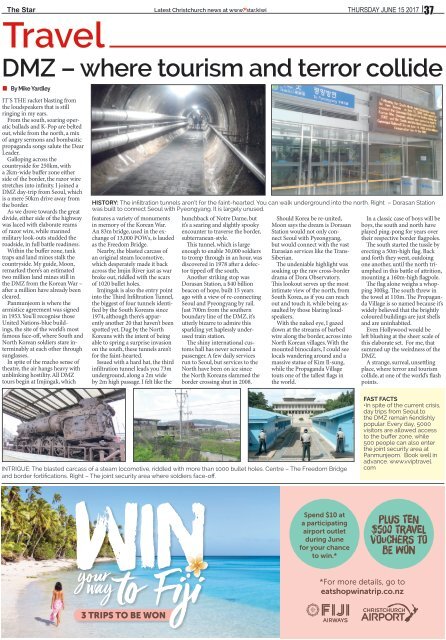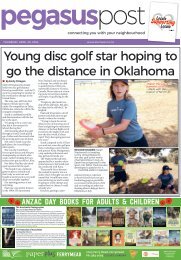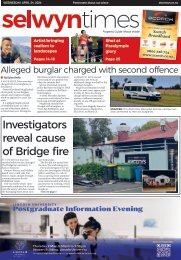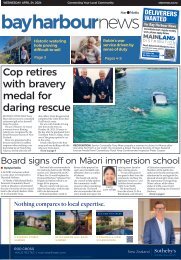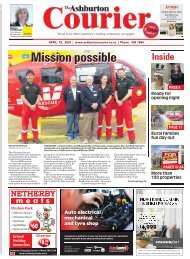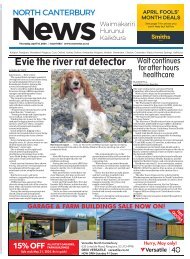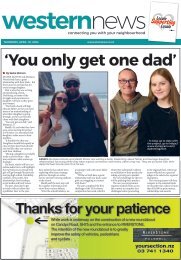The Star: June 15, 2017
Create successful ePaper yourself
Turn your PDF publications into a flip-book with our unique Google optimized e-Paper software.
<strong>The</strong> <strong>Star</strong> Latest Christchurch news at www. .kiwi<br />
Thursday <strong>June</strong> <strong>15</strong> <strong>2017</strong> 37<br />
Travel<br />
DMZ – where tourism and terror collide<br />
• By Mike Yardley<br />
IT’S THE racket blasting from<br />
the loudspeakers that is still<br />
ringing in my ears.<br />
From the south, soaring operatic<br />
ballads and K-Pop are belted<br />
out, while from the north, a mix<br />
of angry sermons and bombastic<br />
propaganda songs salute the Dear<br />
Leader.<br />
Galloping across the<br />
countryside for 250km, with<br />
a 2km-wide buffer zone either<br />
side of the border, the razor wire<br />
stretches into infinity. I joined a<br />
DMZ day-trip from Seoul, which<br />
is a mere 50km drive away from<br />
the border.<br />
As we drove towards the great<br />
divide, either side of the highway<br />
was laced with elaborate reams<br />
of razor wire, while manned<br />
military look-outs studded the<br />
roadside, in full battle readiness.<br />
Within the buffer zone, tank<br />
traps and land mines stalk the<br />
countryside. My guide, Moon,<br />
remarked there’s an estimated<br />
two million land mines still in<br />
the DMZ from the Korean War –<br />
after a million have already been<br />
cleared.<br />
Panmunjeom is where the<br />
armistice agreement was signed<br />
in 1953. You’ll recognise those<br />
United Nations-blue buildings,<br />
the site of the world’s most<br />
famous face-off, where South and<br />
North Korean soldiers stare interminably<br />
at each other through<br />
sunglasses.<br />
In spite of the macho sense of<br />
theatre, the air hangs heavy with<br />
unblinking hostility. All DMZ<br />
tours begin at Imjingak, which<br />
HISTORY: <strong>The</strong> infiltration tunnels aren’t for the faint-hearted. You can walk underground into the north. Right – Dorasan Station<br />
was built to connect Seoul with Pyeongyang. It is largely unused.<br />
features a variety of monuments<br />
in memory of the Korean War.<br />
An 83m bridge, used in the exchange<br />
of 13,000 POWs, is lauded<br />
as the Freedom Bridge.<br />
Nearby, the blasted carcass of<br />
an original steam locomotive,<br />
which desperately made it back<br />
across the Imjin River just as war<br />
broke out, riddled with the scars<br />
of 1020 bullet holes.<br />
Imjingak is also the entry point<br />
into the Third Infiltration Tunnel,<br />
the biggest of four tunnels identified<br />
by the South Koreans since<br />
1974, although there’s apparently<br />
another 20 that haven’t been<br />
spotted yet. Dug by the North<br />
Koreans with the intent of being<br />
able to spring a surprise invasion<br />
on the south, these tunnels aren’t<br />
for the faint-hearted.<br />
Issued with a hard hat, the third<br />
infiltration tunnel leads you 73m<br />
underground, along a 2m wide<br />
by 2m high passage. I felt like the<br />
hunchback of Notre Dame, but<br />
it’s a searing and slightly spooky<br />
encounter to traverse the border,<br />
subterranean-style.<br />
This tunnel, which is large<br />
enough to enable 30,000 soldiers<br />
to tromp through in an hour, was<br />
discovered in 1978 after a defector<br />
tipped off the south.<br />
Another striking stop was<br />
Dorasan Station, a $40 billion<br />
beacon of hope, built <strong>15</strong> years<br />
ago with a view of re-connecting<br />
Seoul and Pyeongyang by rail.<br />
Just 700m from the southern<br />
boundary line of the DMZ, it’s<br />
utterly bizarre to admire this<br />
sparkling yet haplessly underused<br />
train station.<br />
<strong>The</strong> shiny international customs<br />
hall has never screened a<br />
passenger. A few daily services<br />
run to Seoul, but services to the<br />
North have been on ice since<br />
the North Koreans slammed the<br />
border crossing shut in 2008.<br />
Should Korea be re-united,<br />
Moon says the dream is Dorasan<br />
Station would not only connect<br />
Seoul with Pyeongyang,<br />
but would connect with the vast<br />
Eurasian services like the Trans-<br />
Siberian.<br />
<strong>The</strong> undeniable highlight was<br />
soaking up the raw cross-border<br />
drama of Dora Observatory.<br />
This lookout serves up the most<br />
intimate view of the north, from<br />
South Korea, as if you can reach<br />
out and touch it, while being assaulted<br />
by those blaring loudspeakers.<br />
With the naked eye, I gazed<br />
down at the streams of barbed<br />
wire along the border, across into<br />
North Korean villages. With the<br />
mounted binoculars, I could see<br />
locals wandering around and a<br />
massive statue of Kim Il-sung,<br />
while the Propaganda Village<br />
touts one of the tallest flags in<br />
the world.<br />
In a classic case of boys will be<br />
boys, the south and north have<br />
played ping-pong for years over<br />
their respective border flagpoles.<br />
<strong>The</strong> south started the tussle by<br />
erecting a 50m-high flag. Back<br />
and forth they went, outdoing<br />
one another, until the north triumphed<br />
in this battle of attrition,<br />
mounting a 160m-high flagpole.<br />
<strong>The</strong> flag alone weighs a whopping<br />
300kg. <strong>The</strong> south threw in<br />
the towel at 110m. <strong>The</strong> Propaganda<br />
Village is so named because it’s<br />
widely believed that the brightly<br />
coloured buildings are just shells<br />
and are uninhabited.<br />
Even Hollywood would be<br />
left blushing at the sheer scale of<br />
this elaborate set. For me, that<br />
summed up the weirdness of the<br />
DMZ.<br />
A strange, surreal, unsettling<br />
place, where terror and tourism<br />
collide, at one of the world’s flash<br />
points.<br />
INTRIGUE: <strong>The</strong> blasted carcass of a steam locomotive, riddled with more than 1000 bullet holes. Centre – <strong>The</strong> Freedom Bridge<br />
and border fortifications. Right – <strong>The</strong> joint security area where soldiers face-off.<br />
FAST FACTS<br />
•In spite of the current crisis,<br />
day trips from Seoul to<br />
the DMZ remain fiendishly<br />
popular. Every day, 5000<br />
visitors are allowed access<br />
to the buffer zone, while<br />
500 people can also enter<br />
the joint security area at<br />
Panmunjeom. Book well in<br />
advance. www.vviptravel.<br />
com<br />
Spend $10 at<br />
a participating<br />
airport outlet<br />
during <strong>June</strong><br />
for your chance<br />
to win.*<br />
*For more details, go to<br />
eatshopwinatrip.co.nz


